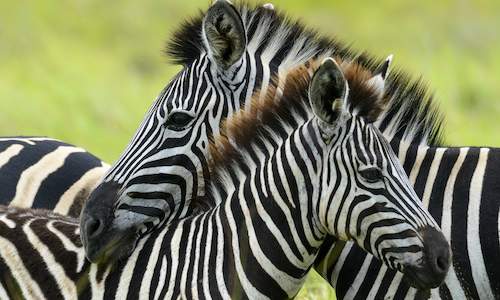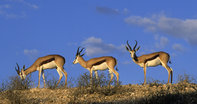
Springbok
Name
Springbok (antidorcas marsupialis)
Appearance
A springbok ewe is much smaller than a ram, with a mass of 37 kg to the males’ 50 kg. Both sexes have horns, however, the ewes' are narrower and shorter than the rams’. The springbok is easy to recognize by its prominent cinnamon-coloured body and white underparts, marked on the flanks from front to rear legs by a dark brown line. The rump has a white triangular marking, lined by a dark brown stripe – the tip of the triangle touching the top of the hindquarters. Their short tails are white and tufted in brown.
Springbok Diet
Springboks feeds selectively, only eating the best fodder they can find and have a penchant for the flowers of the acacia tree. They browse in the dry season, and mainly graze after the rainy months when the new grasses grow. When open water sources are scarce they meet their water requirements by feeding on tubers and roots that are rich in moisture.
Springbok Breeding
After a gestation period of 25 weeks, a single lamb is born. Ewes hide their lambs for the first two days after their birth, and wean them at about four months of age. Spingboks have no specific breeding period in South Africa, and mating occurs within a one to two week rut. Ewes normally breed every year, and twice a year at times. The young reach sexual maturity at seven months.
Springbok Behaviour
The composition of a springbok herd varies. Rams establish territories for mating opportunities, and territorial rams prefer to live unaccompanied in their areas of land.
Springbok Habitat
The springbok prefers grass savanna, dry river beds and calcareous pans as their habitat in South Africa, avoiding tall grass. They tend to live in harsh and unpredictable areas.
Where they are found
The springbok is common in South Africa’s central and western regions, populating most of the country’s private game reserves and national parks. Most springbok herds are limited to farmlands and reserves, yet some freely roam areas within their natural range.
Field Notes
When the settlers first arrived in Southern Africa, springbok roamed the dry regions in hundreds of thousands. They were quickly decimated, however, and now can predominantly be found in protected areas of reserves and farmland. Whether the springbok should be the national animal of South Africa continues to be a contentious issue, as it is believed to be a symbol of Apartheid. South Africa’s national rugby team is still named the Springboks, however.

Learning about the mammals of South Africa is now so much easier for all South Africans - SouthAfrica.co.za is an excellent source of inform...
more
